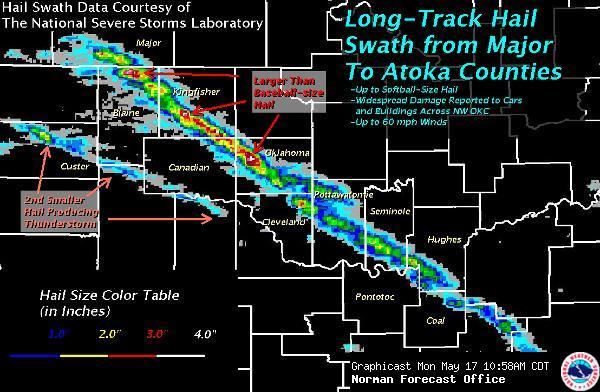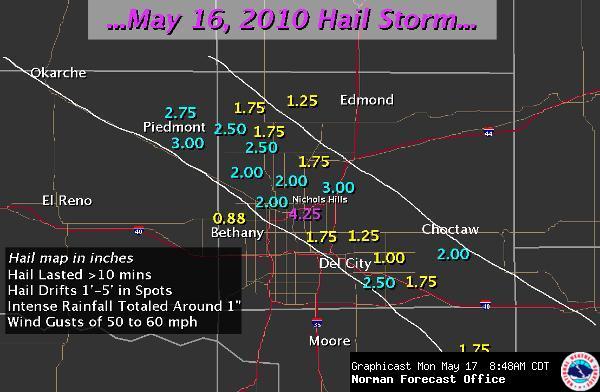Ticker for May 17, 2010
MESONET TICKER ... MESONET TICKER ... MESONET TICKER ... MESONET TICKER ...
May 17, 2010 May 17, 2010 May 17, 2010 May 17, 2010
What the Hail!
The hits just keep on coming, and yesterday's gem from Mother Nature was a hail
storm for the ages in central Oklahoma (graphics courtesy of the Norman NWS
office):


Hail to the size of softballs was reported yesterday in Blaine and Oklahoma
Counties. Damage from the storm was widespread and costly, surely running into
the tens (if not hundreds) of millions of dollars. It differs from a tornado
damage path in that it is not as violent, but the footprint is much larger.
Hail As A Hazard
While flooding is the most deadly severe thunderstorm hazard, hail is the most
costly, and parts of Oklahoma have the highest frequency of large hail events
in the United States.

Large hail is generally one inch in diameter or larger and can fall at speeds
faster than 100 mph. In recent years, the annual loss from hail in this country
has been nearly $2 billion dollars. Oklahoma crop losses due to hail average
approximately $2.5 million per year alone, not including property and casualty
claims. Hail damage to automobiles, roofs, windows and farm crops is staggering.
Large hail is also a threat to small mammals and it kills many birds. Hail
rarely kills people, but deaths do occur. One of the world?s most deadly
hailstorms struck China in 1986, killing 100 people, injuring 9,000, and
destroying 35,000 homes.
Although not a significant threat to human life in the U.S., hail is massively
damaging. This is exemplified by the "Mayfest" hail storm of 1995, the most
expensive thunderstorm event in U.S. history. During this event, hailstones up
to 4 inches in diameter contributed to over $2 billion in damage in Fort Worth,
Texas, along with 109 hail related injuries. That damage potential exists in
Oklahoma as well, indicated by a list of the 15 most damaging hail events in
Oklahoma since 1993, as reported by NCDC.
City Date Damage (millions)
Oklahoma City 04/21/04 75.0-100.0
Jenks 04/05/05 65.0
Norman 11/05/08 40.0
Tulsa 11/18/03 20.0
Waurika 03/29/93 5.0
Ada 04/02/94 5.0
Bromide 04/26/94 5.0
Altus 04/15/00 2.6
Poteau 01/21/99 2.6
Bartlesville 05/08/00 2.0
Tulsa 03/26/00 2.0
Bartlesville 05/20/01 1.0
Hennessey 04/21/99 1.0
Miami 05/04/03 1.0
Tulsa 05/05/00 1.0
Other significant events exist prior to the official listing by NCDC. On
November 13, 1985, baseball-sized hailstones driven by 60 mph winds battered
parts of Tulsa County. Damages exceeded $37 million. On October 5, 1951, crops
were destroyed along a five mile wide, 70 mile long swath across Harmon, Greer,
and Kiowa counties. Accompanied by very strong winds, the hail destroyed 18,000
acres of cotton and sorghum. Total losses included $175,000 in crops and
$70,000 to buildings and automobiles (at 1951 prices).
A Brief Look at Destructive Oklahoma Hail Events Since 1993
Oklahoma City ? April 21, 2004
The most damaging hail event in Oklahoma history, a hailstorm pummeled central
Oklahoma on April 20, 2004, associated with a supercell that rumbled through
Yukon and Oklahoma City. Damage estimates have ranged from $75-$100 million
from the hail that reached the size of baseballs. The slow-moving storm buried
parts of the city in ice until it resembled a winter landscape. Low-lying areas
had shelves of ice two feet thick as thousands of hailstones stuck together and
became compacted. Cars had difficulty navigating streets covered in the thick
ice sheets.
Jenks - April 5, 2005
A supercell thunderstorm moved north-northeast across the central portion of
Tulsa County producing a several mile wide swath of large, damaging hail.
Reports of golfball or larger hail was common in a densely populated area of
the county from Jenks to across the City of Tulsa. The largest hailstones
reported were 3 inches in diameter. Many automobiles, homes, and businesses
were damaged by the hailstorm. - Courtesy of the NCDC Climate Events Database
Norman - November 5, 2008
Abundant amounts of quarter to golfball size hail were reported near and around
Northwest 36th street and Tecumseh Road. Severe winds also occurred, estimated
at 60 mph. The combination of wind and hail caused widespread significant
damage to roofs, windows, fences and vehicles. Most homes on the northwest side
of Norman suffered some type of damage,especially in the area bounded by Rock
Creek Road on the south, 48th Avenue NW on the west, Franklin Road on the
north, and Interstate 35 on the east. Local damage assessments found thousands
of residents had to get their roofs replaced, and many also suffered significant
damage to windows, screens, fences, outbuildings and siding. In addition,
numerous vehicles were damaged by the hail, with many assessed to be total
losses. Damage estimates for roof, window, and fence replacement ranged from
$15,000 to $35,000 per house in northwest Norman. - Courtesy of the NCDC
Climate Events Database
Tulsa ? November 18, 2003
Hail the size of baseballs fell on Tulsa, causing $20 million in damage.
Enough hail feel that it looked like snow had accumulated. The storm that
produced the hail moved through the city just before 10 a.m. and hail as large
as 2.75 inches was reported in midtown Tulsa. As many as 2,500 customers were
without power after the storms moved through. Major structural damage was
reported in the city and surrounding areas.
Waurika ? March 29, 1993
Just before 10 p.m., tennis ball-sized hail began to fall in Waurika as storms
moved over the state line from Texas. Damage from the storm was estimated at
$5 million.
Ada ? April 2, 1994
Damage that occurred in Ada from this storm began around 6:45 p.m. and totaled
$5 million. The largest hail reported was 2.5 inches. Funnel clouds were also
reported three miles south of Ada at about 6:50 p.m.
Bromide ? April 26, 1994
Just before 1 p.m., large hail began to pound Bromide. Hail as large as
baseballs contributed to the $5 million total in damages. Along with the
structural damages, three people were also injured.
Altus ? April 15, 2000
Nearly $3 million in damage occurred in Altus this day after hail as large as
baseballs fell on the city. Of the damages, $2 million occurred to homes and
businesses and $600,000 occurred to vehicles. These severe thunderstorms
affected a large part of western Oklahoma during the afternoon and evening
hours of the 15th before weakening across central Oklahoma.
Poteau ? January 21, 1999
In response to an advancing dryline and a powerful upper level jet, storms
formed across southeast Oklahoma and went on to produce impressive hail damage.
In Poteau, $2.6 million in damage occurred as a fairly small storm moved
northeast through the city. Although small, the storm produced golfball size
hail and badly damaged many cars.
Bartlesville ? May 8, 2000
Baseball-size hail hit the city of Bartlesville on this day and resulted $2
million in damage. The hospital suffered severe roof damage as the storm moved
through. Hail damaged hundreds of cars at several dealerships and smashed the
windows of several Bartlesville police cars.
Tulsa ? March 26, 2000
Around 4:30 p.m., Tulsa was hit with a damaging hail storm that produced tennis
ball size hail. Large hail fell from downtown through western and southern
parts of the city. Many cars and roofs were damaged and many windows were
broken by the wind driven hail. Damage from the storm accumulated to $2
million.
Bartlesville ? May 20, 2001
On the afternoon of May 20, 2001, Bartlesville was hit with a hail storm that
went on to produce $1 million in damage. The largest of the hail reports were
1.75 inches.
Hennessey ? April 21, 1999
This day had a little bit of everything in the area around Hennessey.
Tornadoes, strong straight line winds, and damaging hail were all reported.
Large and destructive hail fell in many areas including Hennessey, where an
unusually large amount of golf ball to baseball size hail fell several times,
causing extensive damage to vehicles, homes, and the wheat crop. Total damages
from the storm in Hennessey came to $1 million.
Miami ? May 4, 2003
Around 5 p.m., power lines and large trees were blown down, and some buildings
had their roofs blown off by this severe storm. Baseball-sized hail caused
significant damage to about 160 cars at an automobile dealership, which
contributed to the total cost of $1 million.
Tulsa ? May 5, 2000
Shortly after 9:00 p.m. on May 5, 2000, Tulsa was hit with a variety of large
hail. Quarter, golf ball, and baseball size hail were all reported in the city.
The damage from the hail storm totaled to $1 million.
Gary McManus
Associate State Climatologist
Oklahoma Climatological Survey
(405) 325-2253
gmcmanus@mesonet.org
May 17 in Mesonet History
| Record | Value | Station | Year |
|---|---|---|---|
| Maximum Temperature | 101°F | HOLL | 2022 |
| Minimum Temperature | 37°F | CAMA | 2009 |
| Maximum Rainfall | 3.66″ | PORT | 2002 |
Mesonet records begin in 1994.
Search by Date
If you're a bit off, don't worry, because just like horseshoes, “almost” counts on the Ticker website!